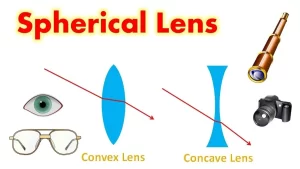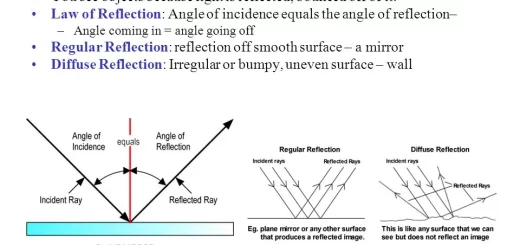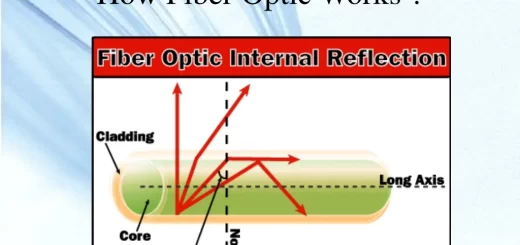Lenses use, types, Convex lens, Concave lens, Vision defects, Contact lenses and Cataract
The convex lens is called the converging lens, while the concave lens is called the diverging lens. The convex lens is called a converging lens because it refracts the rays towards the principal axis, so it collects light rays falling on it. The concave lens is called a diverging lens because it refracts the rays away from the principal axis, so it separates light rays falling on it.
Lenses
Lenses are the basic structural unit in all these optical tools. The lens is usually made of clear glass or transparent plastic, So the lens is a transparent medium that refracts the light and it is limited with two spherical surfaces.
Uses of lenses
Lenses are used in many fields:
- In medical eyeglasses, Either for reading or walking
- In some types of telescopes, to form near and enlarged images of the celestial bodies.
- In microscopes, to form magnified images for tiny bodies that can’t be seen by the naked eye.
- In binoculars, to see the far object.
- In a magnifier lens, to see the minute parts.
Types of lenses
Lenses have many types, among them are
- Convex lens (converging lens). A convex lens is a transparent optical piece that is thick at its centre and has less thickness at the tips. A convex lens is called a “converging lens”. As it collects light rays falling on it.
- Concave lens (diverging lens). A concave lens is a transparent optical piece that is thin at its centre and has more thickness at the tips. A concave lens is called a “diverging lens”. As it separates light rays falling on it.
Special concepts related to the lenses
- The centre of curvature of the lens face (C): It is the centre of the sphere, where this face is a part of it. eg. C1 & C2. The lens has two centres of curvature because it has two spherical surfaces, each surface has a center.
- The optical centre of the lens (P): It is a point inside the lens that lies on the principal axis in the mid-distance between its two faces.
- The radius of curvature of the lens face (r): It is half the diameter of the sphere, where this face is a part of it.
- The principal axis: It is the straight line that joins between the two centres of curvature of the lens passing by the optical centre of the lens. The lens has only one principal axis.
- The secondary axis: It is any line that passes by the optical centre of the lens except the principal axis. The lens has an uncountable number of secondary axes.
- The focus of the lens (F) (principal focus): It is the point of collection of the refracted light rays (in the convex lens) or their extensions (in the concave lens), It is produced when the beam of parallel rays falls parallel to the principal axis of a lens, It is a Real focus, in case of the convex lens. Virtual focus, in the case of the concave lens. The lens has two focuses (foci).
- The focal length of the lens (f) is the distance between the principal focus and the optical centre of the lens.
When a beam of light rays parallel to the principal axis falls on the surface of:
- Convex lens: The parallel rays pass through the convex lens, then they converge in a lit point which is known as the real focus of the lens.
- Concave lens: The parallel rays pass through the concave lens, then they are diverged and their extensions are collected in a lit point which is known as the virtual focus of the lens.
Convex lens
The convex lens is a converging lens as it collects the refracted light rays, The point of collection of the parallel rays (produced from the Sun or any distant object) is called “the focus of the lens (F)”, The distance between the focus of the lens and its optical centre is called “the focal length of the lens (f).
The formed image by the convex lens can be received on the screen because it is a real image formed by the collection of the refracted light rays. A piece of paper can be burnt by a convex lens because the convex lens can converge and concentrate the parallel rays of sunlight in a point (real focus) which leads to the burning of this paper.
The thin lens has a large focal length as the convexity of its lens face is small so, the focus is farther to the optical centre. The thick lens has a small focal length as the convexity of its lens face is large so, the focus is nearer to the optical centre. The focal length of the thick convex lens is less than that of the thin convex lens because the radius of the thin lens is bigger than that of the thick lens.
Rules for determining the direction of the light rays after passing through the convex lens
- When the incident ray is parallel to the principal axis, the emergent ray exits (or refracts) from the lens passing through the focus.
- When the incident ray passes through the focus. the emergent ray exits (or refracts) from the lens parallel to the principal axis.
- When the incident ray passes through the optical centre, the emergent ray passes through the lens without refraction.
When you place an object in front of a convex lens, the position of the formed image and its properties can be determined by using only two rays from the previous three rays, where the image is formed at the intersection of the refracted rays or their extensions.
The cases of the formation of the images by the convex lens (converging lens)
To determine the position and properties of the formed images by the convex lens, follow the following steps:
- Use the compass to draw two identical intersected circles, where: The region of intersection represents the convex lens. The two centres of the two circles represent the two centres of curvature of the lens (C).
- Draw a straight line that joins between the two centres of curvature of the lens to represent the principal axis of the lens. Put a point in the mid-distance between the two lens faces on the principal axis to represent the optical centre of the lens (P). Put two points in the mid-distance between (C) & (P) to represent the two focuses of the lens (F).
- Draw a vertical arrow on the principal axis to represent the position of the object.
- Draw a ray from the highest point of the object, where it falls parallel to the principal axis and thus refracts and exits passing through the focus.
- Draw another ray from the same point passing through the optical centre of the lens. so it exits without refraction.
- Draw an arrow, whose head is at the position of the intersection of the two refracting rays, to represent the formed image of the highest of the object.
- Position of the formed image: Between (F) & (C). Properties of the formed image: Real, inverted, and diminished (smaller than the object).
- Repeat the steps from 3 to 7 several times by changing the position of the object each time.
Properties of the formed images by the convex lens
The properties of the formed images by the convex lens are different according to the position of the object from the lens as the following:
- When the object is very far from the lens [the incident light rays are parallel to each other and to the principal axis). the image is at the focus, the image is real and very tiny (tiny).
- When the object is at a distance greater than double the focal length, the image is between the focus (F) and the centre of curvature (C), the image is real, inverted, and diminished [smaller than the object].
- When the object is at a distance equals to double the focal length [At the centre of curvature (C). the image is at the centre of curvature (C), the image is real, inverted, and equal to the object.
- When the object is at a distance greater than the focal length, but less than double the focal length [Between the focus (F) and the centre of curvature (C)], the image is at a distance greater than double the focal length, the image is real, inverted, magnified [larger than the object].
- If the object is at the focus, No image is formed.
- When the object is at a distance less than focal length [Between the focus (F) and the optical centre (P)]. The image is formed farther than the object position (according to the lens), and in its same direction, the image is virtual, erect, and magnified.
No image is formed when the object is placed at the focus of a convex lens because the refracted rays from a lens don’t meet and pass through a parallel way at infinity.
Concave lens
If the convex lens is replaced with a concave lens, the formed image cannot be received on the screen, because it is a virtual image formed as a result of the intersection of the extensions of the refracted light rays.
The properties of the formed image by the concave lens
- The position of the object: Wherever the position of the object in front of the concave lens.
- The position of the image: The image is formed nearer to the object’s position (according to the lens), and in the same side.
- The properties of the formed image are always: Virtual, Erect, and Diminished.
It is impossible to obtain a real image by using a concave lens because the real image is formed as a result of the intersection of the refracted light rays, but the concave lens forms an image as a result of the intersection of the extensions of the refracted light rays which is called a virtual image.
The collective lens has two foci, but the collective mirror has one focus because the convex (collective) lens has two spherical surfaces, but the concave (collective) mirror has one spherical surface.
The vision
How does the vision occur?
The light rays reflected from the body to fall on the eye, refract when passing through the cornea, then the eye lens (convex lens). The refracted light rays fall on the retina forming a real, inverted, and diminished image. The optic nerve transmits the image to the brain which re-corrects the image to be seen erect, in normal size, and in its normal position.
The diameter of the eyeball is the distance between the optical centre of the lens and the retina. To see clearly, the image must be formed exactly on the retina. The normal person can see clearly:
- Near objects (at a distance not less than 25 cm).
- Far objects (at a distance not more than 6 m).
The use of lenses to treat vision defects:
Vision defects occur because the eye lens is not always convex or the eyeball is not always spherical. The most important vision defects are:
- Short-sightedness.
- Long-sightedness
Short-sightedness
Short-sightedness is a vision defect through which near objects only can be seen clearly but far objects seem distorted.
Reasons:
- An increase in the eyeball diameter causes the retina to be far from the eye lens.
- An increase in the convexity of the eye lens surface causes a shorter focal length for the eye lens.
This leads to: the light rays coming from the far object are collected at a point in front of the eye retina and disperses after that forming an unclear image.
Correction: It is corrected by using a concave lens which diverges the rays before falling on the eye, so the image of the object is formed exactly on the retina. Therefore, the short-sighted person needs medical eyeglasses with concave lenses.
The concave lens is used to correct short-sightedness because it diverges the rays coming from far objects before falling on the eye, so the image is formed exactly on the retina. For a person who has short-sightedness, the retina is far from the eye lens due to the increase in the eyeball diameter.
A short-sighted person sees the far objects distorted because the images of these objects do not fall on the retina of the eye, but in front of it. Some persons have short-sightedness. Due to the increase in the eyeball diameter, and the increase in convexity of the eye lens surface.
Long-sightedness
Long-sightedness is a vision defect through which far objects only can be seen clearly but near objects seem distorted.
Reasons:
- A decrease in the eyeball diameter causes the retina to be close to the eye lens.
- A decrease in the convexity of the eye lens surface causes a longer focal length for the eye lens.
This leads to: The light rays coming from the near object are collected at a point behind the eye retina and disperses after that forming an unclear image.
Correction: It is corrected by using a convex lens that collects the rays before falling on the eye, so the image of the object is formed exactly on the retina. Therefore, the long-sighted person needs medical eyeglasses with convex lenses.
The convex lens is used to correct long-sightedness because it collects the rays coming from near objects before falling on the eye, so the image is formed exactly on the retina.
Some persons have long-sightedness due to the decrease in the eyeball diameter and the decrease in the convexity of the eye lens surface. A long-sighted person cannot see close objects clearly because the images of the close objects don’t fall on the retina, but behind it. The retina is close to the eye lens in a long-sighted person due to the decrease of the eyeball diameter.
The near objects are collected behind the eye retina in long-sightedness due to the decrease of convexity of the eye surface which results more focal length, so the rays coming from the near object are collected in a point behind the eye retina.
Contact lenses
Contact lenses are used instead of medical glasses to treat vision defects. The contact lens is a very thin lens made of plastic and can stick to the eye cornea by the eye fluid.
Cataract
A cataract is one of the most dangerous diseases that infects the eye. A cataract is a disease that causes difficulty in vision as a result of the darkness of the eye lens.
The reasons for cataract disease are:
- Old age.
- Illness.
- Side effects of some drugs.
- Genetic readiness.
The result of cataracts is: The difficulty of vision as a result of the darkness of the eye lens.
Treatment of cataract: Treatment is done through surgery to exchange the eye lens (decayed) with a transparent plastic lens transplanted permanently in the eye. So, the person can see again clearly.
Land areas measurement
Land surveyors and topographical scientists use a special device to determine heights and distances by sending a beam of laser rays, then receiving it again by the mirrors and lenses provided in their devices. So, it is possible to make very accurate measurements by calculating the time that the laser beam bounced from a distant point and returned to its source.
To measure the distance: d = ½ (v × t)
How are lenses useful to us?
Lenses are incredibly useful for a variety of purposes because they can manipulate light. Lenses play a vital role in many aspects of our lives, from correcting our vision to enabling scientific discovery and capturing the world around us. Lenses are used to help see clearly, and reveal the invisible world.
Eyeglasses and Contact Lenses can correct common vision problems like nearsightedness and farsightedness. Lenses bend light rays to focus them properly on the retina, allowing us to see clearly.
Magnifying the Invisible: Microscopes use lenses to magnify tiny objects many times their size, allowing scientists and doctors to examine details invisible to the naked eye. Microscopes allow scientists and researchers to explore the world of cells, bacteria, and other microscopic life.
Magnifying Glasses can enlarge small objects for closer inspection, useful for jewelers, watchmakers, and anyone who needs a closer look at details.
Seeing Faraway Objects: Telescopes use lenses (and mirrors) to gather and focus light from distant objects in space, allowing us to observe planets, stars, and galaxies. Telescopes can magnify distant objects in space, helping us explore the universe.
Capturing Images: Cameras rely on a system of lenses to focus light and create a clear image on film or a digital sensor. The different lenses available for cameras offer a variety of zoom capabilities and effects. The zoom function on many cameras adjusts the lens system to change the magnification. The lens system plays a crucial role in determining factors like zoom, aperture, and overall image quality.
Magnifying glasses use convex lenses to enlarge objects for better viewing. Projectors use lenses to project an image onto a screen, while eyeglasses and sunglasses often incorporate lenses to protect our eyes from sunlight. We encounter lenses in many daily items, like magnifying glasses for reading small print, laser pointers for presentations, and the lenses in our smartphones that help us take sharp pictures.
You can subscribe to Science Online on YouTube from this link: Science Online
You can download the Science Online application on Google Play from this link: Science Online Apps on Google Play
Types and uses of lenses in our life & special concepts related to the lenses
Uses of the concave mirror and the convex mirror in our daily life
Laws of light reflection, Plane mirrors, Spherical mirrors, Concave mirror & Convex mirror
Spherical mirror use, Properties of Images formed by Concave mirror & Convex mirror




